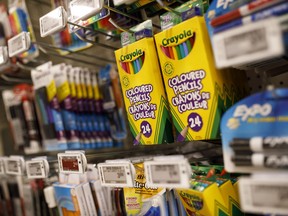Sandra Fry: Back-to-school shopping is an ideal time to teach kids about money

Reviews and recommendations are unbiased and products are independently selected. Postmedia may earn an affiliate commission from purchases made through links on this page.
Article content
Ensuring our kids have the best start in life often means teaching them the lessons we wish we had learned earlier. Whether it’s music, sports or money management, the key is hands-on experience.
But let’s face it, encouraging them to practice, cheering them on when they’re down or reminding them about wise spending can be exhausting. Ever wonder if there’s a simpler way to spark their interest? The great news is, there absolutely is.
Advertisement 2
Article content
Back-to-school shopping is an ideal time to teach kids about money. With their vested interest in planning, budgeting, comparison shopping and actual buying, their motivation to learn money skills is at its peak.
As soon as kids are old enough to spend money, they’re old enough to discuss it in age-appropriate ways. Whether your kids are in primary school, high school or heading off to college, here are some tips to prepare them for the new academic year and equip them with essential life skills.
Begin by teaching your kids the difference between needs and wants, and that many buying decisions fall somewhere between these two extremes. For example, they might need a backpack, but prefer not to settle for the budget brand. The trendy, expensive one they desire might be tempting, but there are likely several styles, brands and price points in between. Help your kids understand that choosing items such as backpacks, jeans, runners, school supplies or laptops at a reasonable price point will allow them to get more of what they want in the long run.
Encourage your kids to get organized by helping them make a master list of what they need for school. This could include items from their school supply lists, technology requirements or clothes they know they’ll need. Once the list is complete, set a budget together. Explain that you’ll assist them in getting what they need within that budget and that you’ll show them how to stretch their funds to make them go further.
Article content
Advertisement 3
Article content
One way to stretch the back-to-school budget is to start by shopping at home. Encourage your kids to check what they already have that can be reused or swapped with a sibling or friend. This promotes sustainability and creativity. Cross those items that you already have off the list and set them aside in a safe place for the start of school.
Next, show your child how to look for sales and discounts. Teach them about digital and print coupons, how to calculate if a discount is truly worth it or when a deal is a deal, and why it can sometimes be beneficial to spend a bit more for better quality rather than always opting for the cheapest option.
Comparison shopping — something adults often do unconsciously due to experience — is an essential skill for kids, teens and young adults to learn. By comparing prices across different stores or online platforms, they can save money and become more aware of what retailers offer and the range of prices for a particular product.
This awareness could help them with their future purchasing decisions. Learning to weigh the pros and cons of different options, such as price, quality and features, enhances critical thinking and decision-making skills. These skills, along with research, are transferable to many aspects of life.
Advertisement 4
Article content
Comparison shopping encourages mindful spending and financial responsibility while simultaneously building patience, discipline and the ability to resist buying impulsively. Overall, being good at comparison shopping boosts someone’s confidence in their ability to effectively manage their money and is a practical skill that can lead to smarter money habits.
As your kids work through their list and decide whether to buy in person or online, they might want to spend more than your budget allows. Help them find ways to come up with extra cash. Teens with part-time jobs might want to supplement their back-to-school budget with their earnings. Younger kids might have birthday or gift money set aside, and young adults heading out on their own might be tempted to use their new credit card before dipping into savings or income.
Before your kids empty their piggy bank or go into debt for one special item, encourage them to discuss why they want that particular item instead of one that suits their budget better. Listen and reflect on their response before sharing your thoughts. They might want the item due to peer pressure or to fit in with a group at school. Perhaps slick marketing has influenced their decision, or the item has an additional feature you weren’t aware of.
Advertisement 5
Article content
If they are choosing based on price, it could reflect budget awareness, an evaluation of the value versus the quality, or modelling what they see adults do. This process of explaining their choices helps them make more thoughtful decisions, develops positive communication skills around money and gives you insight into the money values your child is developing.
Recommended from Editorial
-

What do to if you’re in a payday loan predicament
-

3 reasons why it’s not worth waiting to deal with debt
Money management isn’t a spectator sport and lecturing your kids about money and credit can be counterproductive. Much like riding a bike, kids need practical experience to become good at managing their money. After all, it’s better to learn tough lessons with $100 or even $1,500 at stake than with a $50,000 car loan or $500,000 line of credit.
Sandra Fry is a Winnipeg-based credit counsellor at Credit Counselling Society, a non-profit organization that has helped Canadians manage debt for more than 27 years.
Bookmark our website and support our journalism: Don’t miss the business news you need to know — add financialpost.com to your bookmarks and sign up for our newsletters here.
Article content























Discussion about this post